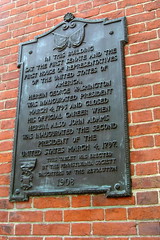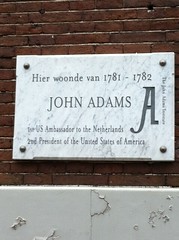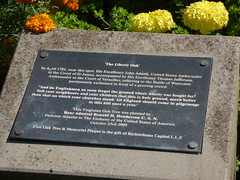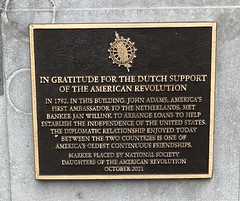John Adams
,_2nd_president_of_the_United_States,_by_Asher_B._Durand_(1767-1845)-crop.jpg?width=250)
,_2nd_president_of_the_United_States,_by_Asher_B._Durand_(1767-1845)-crop.jpg?width=250)
John Adams
(1735-1826)
United States Ambassador to The Netherlands (1782-1788), United States Ambassador to Great Britain (1785-1788), and 2nd President of the United States (1797-1801)
Family tree
Commemorated on 10 plaques
In this house lived John Adams First American Minister to Great Britain, May 1785 to March 1788 afterwards Second President of the United States. From here his daughter Abigail was married to Colonel William Stephens-Smith, First Secretary of the Legation and an Officer in the Revolutionary Army on Washington's staff. John Adams and Abigail, his wife through character and personality, did much to create understanding between the two English-speaking countries. In their memory this tablet is placed by the Colonial Dames of America 1933.
9 Grosvenor Square, London, United Kingdom where they lived
In this building sat the first Senate and the first House of Representatives of the United States of America. Herein George Washington was inaugurated President March 4, 1793 and closed his official career when herein, also John Adams was inaugurated the second President of the United States March 4, 1797.
Congress Hall, Philadelphia, PA, United States where they was inaugurated the second President of the United States (1797)
Hier woonde van 1781-1782 John Adams 1st US Ambassador to The Netherlands, 2nd President of the United States of America
????, Amsterdam, Netherlands where they lived (1780-1781)
En ce bâtiment Jadis Hôtel d'York le 3 septembre 1783 David Hartley, au nom du Roi d'Angleterre, Benjamin Franklin, John Jay, John Adams, au nom des Etats-Unis d'Amérique, ont signé le Traité Définitif de Paix reconnaissant l'indépendence des Etats-Unis.
English translation: In this building formerly York Hotel on September 3, 1783 David Hartley, on behalf of the King of England, Benjamin Franklin, John Jay, John Adams, on behalf of the United States of America, signed the Final Treaty of Peace recognizing the independence of the United States. [AWS Translate]
56 rue Jacob, Paris, France where they signed the Definitive Treaty of Peace recognizing the independence of the United States (1783)
Was proclaimed from York by the Continental Congress on November 1, 1777 to be celebrated on Thursday, December 18. It was written by John Adams of Massachusetts, "The Father of the Revolution," who advocated for the first time "one day of public thanksgiving" for all of the States after the Battle of Saratoga, "that good people may express the grateful feelings of their heart".
21 E. Market St, York, PA, United States where they was (1776)
Adams County. Formed January 22, 1800 out of York County. The name honors President John Adams. Important center of fruit growing industry. County seat of Gettysburg, incorporated 1806, was site in 1863 of key Civil War battle and President Lincoln's great address.
Old Courthouse, Baltimore & W. Middle Sts. (Bus. 15 & PA 116), Gettysburg, PA, United States where they is commemorated
National Funeral for President Washington. George Washington died on December 14, 1799. Congress set Dec. 26 as a day of formal mourning in Philadelphia, the nation's capital from 1790 to 1800. The national funeral service was in Zion Lutheran Church--located at this site, 1766-1870--and among those attending was President John Adams. In his funeral oration, Congressman Henry Lee spoke the famous tribute: "First in war, first in peace and first in the hearts of his countrymen."
SE corner, N 4th & Cherry Streets, Philadelphia, PA, United States where they was
On 8th April 1786 John Adams and Thomas Jefferson - the second and third Presidents of the United States of America - dined in the old Hop Pole Inn, which is the building to the left of this hotel, during their 8-day tour of English gardens and Civil War battle sites. Later, on Fort Royal Hill, Adams demanded of local people: "do Englishmen so soon forget the ground where liberty was fought for? All England should come in pilgrimage to this hill once a year."
Whitehouse Hotel, Worcester, United Kingdom where they dined (1786)
'The Liberty Oak' In April 1786 near this spot, His Excellency John Adams, United States Ambassador to the Court of St James, accompanied by His Excellency Thomas Jefferson, Ambassador to the Court of Versailles, referring to the Battle of Worcester passionately exclaimed in front of a growing crowd: "And do Englishmen so soon forget the ground where liberty was fought for? Tell your neighbours and your children that this is holy ground, much holier than that on which your churches stand. All England should come in pilgramage to this hill once a year." This Virginian Oak Tree was planted by Rear Admiral Ronald H. Henderson, Defence Attaché to the Embassy of the United States of America. October 23rd 2009 This Oak Tree & Memorial Plaque is the gift of Richardsons Capital L.L.P.
Fort Royal Park, Worcester, United Kingdom where they was near (1786)
In gratitude for the Dutch support of the American Revolution In 1782, in this building, John Adams, America's first Ambassador to The Netherlands, met Banker Jan Willink to arrange loans to help establish the independence of The United States. The diplomatic relationship enjoyed today between the two countries is one of America's oldest continuous friendships. Marker placed by National Society Daughters of the American Revolution October 2021
Herengracht 386, Amsterdam, Netherlands where they was

.jpg?width=250)





